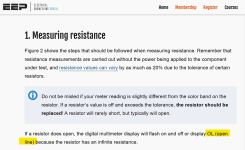dogsbody
Well-known member
In this situation, a small amount of current, as little as 4 or 5 milliamps, is detected by the “sensing coil” built into the GFCI device, and the unit “shuts” off the circuit, stopping the flow.
As a point of reference for those unfamiliar with the subject matter: 4-5mA may not sound like a lot, and it isn't. But it can take as little as 20mA to stop your heart (100mA is more reliable) if the conditions are right, such as touching the voltage source with your left hand, and your right hand (or left leg) well-grounded, either of which will supply a good path through the heart. One of the thing we're taught early is that it's a lot safer to work on hot circuits if you keep one hand in your pocket. But that's why that differential threshold for tripping a GFI is so low.
Last edited:
















